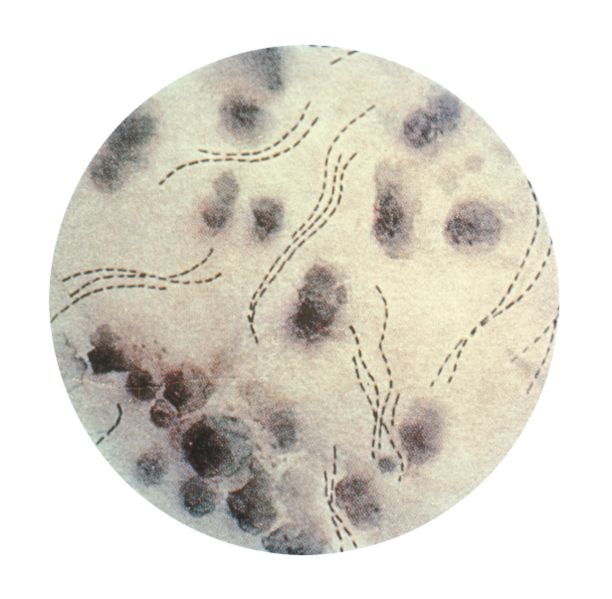Chancroid
| Chancroid | |
 | |
|---|---|
| Photomicrograph of H. ducreyi | |
| ICD-10 | A57 |
| ICD-9 | 099.0 |
| DiseasesDB | 5563 |
| MedlinePlus | 000635 |
| eMedicine | emerg/95 |
| MeSH | D002602 |
|
WikiDoc Resources for Chancroid |
|
Articles |
|---|
|
Most recent articles on Chancroid |
|
Media |
|
Evidence Based Medicine |
|
Clinical Trials |
|
Ongoing Trials on Chancroid at Clinical Trials.gov Clinical Trials on Chancroid at Google
|
|
Guidelines / Policies / Govt |
|
US National Guidelines Clearinghouse on Chancroid
|
|
Books |
|
News |
|
Commentary |
|
Definitions |
|
Patient Resources / Community |
|
Patient resources on Chancroid Discussion groups on Chancroid Directions to Hospitals Treating Chancroid Risk calculators and risk factors for Chancroid
|
|
Healthcare Provider Resources |
|
Causes & Risk Factors for Chancroid |
|
Continuing Medical Education (CME) |
|
International |
|
|
|
Business |
|
Experimental / Informatics |
Chancroid is a sexually transmitted infection characterized by painful sores on the genitalia. Chancroid is known to be spread from one to another individual through sexual contact.
Causes
Chancroid is a bacterial infection caused by the fastidious Gram-negative streptobacillus Haemophilus ducreyi. It is a disease found primarily in developing countries, associated with commercial sex workers and their clientele.
Infection levels are low in the western world, typically around one case per two million of the population (Canada, France, UK and USA). Most individuals diagnosed with chancroid have visited countries or areas where the disease is known to occur frequently, although outbreaks have been observed in association with crack cocaine use and prostitution.
Uncircumcised men are at three times greater risk than circumcised men for contracting chancroid from an infected partner. Chancroid is a risk factor for contracting HIV, due to their ecological association or shared risk of exposure, and biologically facilitated transmission of one infection by the other.
Symptoms and signs
After an incubation period of one day to two weeks, chancroid begins with a small bump that becomes an ulcer within a day of its appearance. The ulcer characteristically:
- Ranges in size dramatically from 3 to 50 mm (1/8 inch to two inches) across
- Is painful
- Has sharply defined, undermined borders
- Has irregular or ragged borders
- Has a base that is covered with a gray or yellowish-gray material
- Has a base that bleeds easily if traumatized or scraped
More specifically, the CDC's standard clinical definition for a probable case of chancroid includes all of the following:
- Patient has one or more painful genital ulcers. The combination of a painful ulcer with tender adenopathy is suggestive of chancroid; the presence of suppurative adenopathy is almost pathognomonic.
- No evidence of Treponema pallidum is indicated by dark-field examination of ulcer or by a serologic test for Syphilis performed at least 7 days after the onset of ulcer.
- The clinical presentation is not typical of disease caused by human herpesvirus 2 (Herpes Simplex Virus), or result of culture for HSV is negative.
About half of infected men have only a single ulcer. Women frequently have four or more ulcers, with fewer symptoms. The ulcers appear in specific locations, such as the coronal sulcus of the uncircumcised glans penis in men, or the fourchette and labia minora in women.
Common locations in men (from most common to least common)
- Foreskin (prepuce) (most common)
- Groove behind the head of the penis (coronal sulcus)
- Shaft of the penis
- Head of the penis (glans penis)
- Opening of the penis (urethral meatus)
- Scrotum (least common)
Common locations in women
In women the most common location for ulcers is the labia majora. "Kissing ulcers" may develop. These are ulcers that occur on opposing surfaces of the labia. Other areas such as the labia minora, perineal area, and inner thighs may also be involved. The most common symptoms in women are pain with urination and pain with intercourse.
The initial ulcer may be mistaken as a "hard" chancre, the typical sore of primary syphilis, as opposed to the "soft chancre" of chancroid.
Approximately one third of the infected individuals will develop enlargements of the inguinal lymph nodes, the nodes located in the fold between the leg and the lower abdomen.
Half of those who develop swelling of the inguinal lymph nodes will progress to a point where the nodes rupture through the skin producing draining abscesses. The swollen lymph nodes and abscesses are often referred to as buboes.
Treatment
The CDC recommendation for chancroid is a single oral dose of Azythromicin or a single IM dose of Ceftriaxone or oral Erythromycin for seven days.
External links
- Chancroid vaccine promising in pigs in Reuters Health
de:Ulcus molle dv:ޝެންކްރޮއިޑް id:Syankroid it:Ulcera venerea he:צ'נקרואיד la:Ulcus molle nl:Ulcus molle fi:Pehmeä sankkeri sv:Mjuk schanker